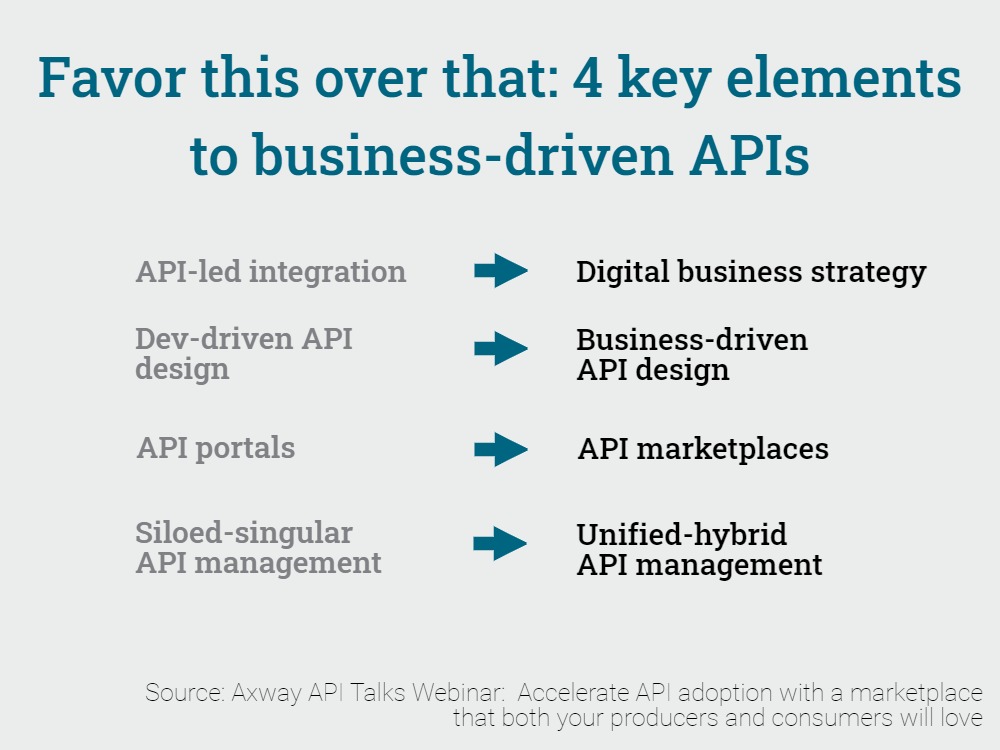Business and software have always had a deeply connected relationship, but how the two relate has evolved over time. Not so long ago, the train of thought was to first define business goals and then write software code to accommodate those objectives. In today’s market, the script has been flipped: the software that embodies your business becomes your business, playing as much of a role as financing, logistics, and other essential functions.
This mindset lends itself to the idea of building your business with APIs. Rather than seeing them as a technical interface, APIs are transformed into business enablers — ones that a well-thought-out marketplace can bring to API product managers, CEOs, and other business professionals.
Recently, I had the chance to sit down with Randy Heffner, a software industry analyst and independent consultant, and discuss this idea of taking a digital business approach to APIs. Here are some highlights from that discussion.
A modern company with a business-driven API mindset
While Amazon may have started out as an online bookstore, today we know it as the largest e-commerce company in the world. As the company expanded their marketed goods to include music, clothes, toys, and more, they started to realize their adeptness in e-commerce.
With that realization came the roots of Amazon Marketplace — an e-commerce platform that lets third-party sellers sell their product offerings on Amazon, with Amazon getting a portion of the sellers’ profits.
To support these third-party sellers in growing their business, Amazon developed a Selling Partner API. Sellers can find APIs that provide data about orders, payments, and shipments — and from these insights, they can boost efficiency and improve response times to customers.
Today, third-party sellers and products are seamlessly integrated into the Amazon buying experience, and all the while, the developers behind the APIs see increased profits.
How to change the API mindset in your organization
“What makes the change in any organization is an executive epiphany.”
– Randy Heffner, software industry analyst/independent consultant
As Heffner’s words suggest, moving toward the concept of business-driven APIs is a matter of changing company culture from the top down.
Business leaders need to move away from this place of I understand that software is important to the company to a place of I understand how software forms and can control what our business can do.
Developers may have a clear understanding of how software can serve a business, but they need to be able to speak the same language as business leaders to get their point across.
Instead of talking about APIs, talk about digital products. Emphasize the change you’re going to initiate in business terms, not in technical software terms.
In many cases, seeing is believing. When you can develop a test API that aligns with your business goals and give your executives a sense of what’s possible with these digital products, you can start to have more of those meaningful conversations around how APIs can shape your business for the future.
Favor this over that: 4 key elements to business-driven APIs

1. Favor digital business strategy over API-led integration
While API-led integration is framed as a technical strategy centered around applications, a digital business strategy sees APIs as business capabilities with staying power.
There’s often the thought that if you produce a lot of APIs, you’re agile. But real agility comes from delivering open-ended APIs that can be easily reconnected to create new models and continue to serve the business in the future.
2. Favor business-driven API design over dev-driven API design
We want to make all these applications API-enabled, so let’s put a bunch of APIs on them. It’s often the stance many companies take in API design, but what happens is the APIs become centered around the application and not the business.
Business-driven APIs start at the opposite end, leading with questions like how do we do business to find APIs that provide relevant capabilities and can generate outcomes.
3. Favor API marketplaces over API portals
Before you can bring people together to collaborate using your APIs, you need to have an API presence. While API portals can serve this function, they are centralized around the API themselves, with the main goal of tracking and managing API use.
On the other hand, API marketplaces are focused on the portfolio of business APIs, the collaboration that’s happening with others, and flexible governance. Backed by this business mindset, the main goal of API marketplaces is to build relationships and ecosystems.
See also: API marketplaces + API Catalog | Innovation for your digital strategy
4. Favor unified-hybrid API management over siloed-singular API management
When we talk about siloed management, you’re often dealing with REST APIs and hybrid configurations across clouds. Unified-hybrid management, meanwhile, deals with multiple APIs and is built to unify divergent API strategies, API gateways, and more.
If you consider the multi-world space we live in and new dimensions that will take shape, adopting a hybrid-driven approach offers a well-planned strategy for future endeavors.


